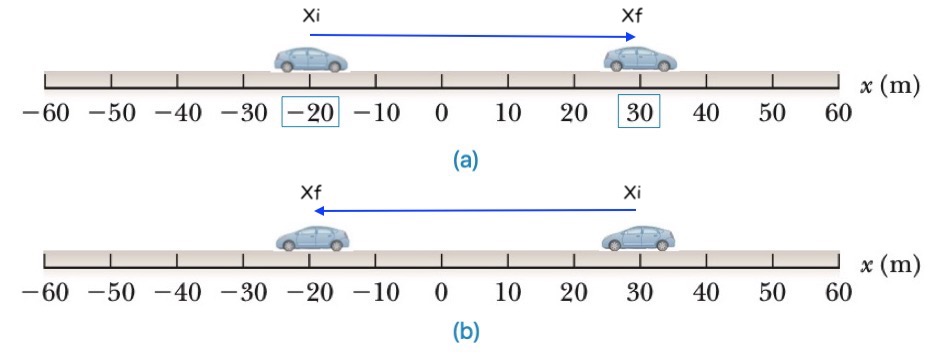Distance, Displacement, speed and velocity
A object's position `x` is the location of the particle with respect to a chosen reference point that we can consider to be the origin of a coordinate system.
Example:
Positions of a cars
 Position of car A: `0\ m`
Position of car B: `40\ m`
Position of car C: `-30\ m`
Distance and Displacement
Position of car A: `0\ m`
Position of car B: `40\ m`
Position of car C: `-30\ m`
Distance and Displacement
 (a)
distance the car traveled:
`d = 20\ m + 30\ m = 50\ m`
displacement of the car:
`∆x = x_f-x_i = 30\ m - (-20\ m) = 50\ m`
(b)
distance the car traveled:
`d = 20\ m + 30\ m = 50\ m`
displacement of the car:
`∆x = x_f-x_i = -20\ m - (30\ m) = -50\ m`
(a)
distance the car traveled:
`d = 20\ m + 30\ m = 50\ m`
displacement of the car:
`∆x = x_f-x_i = 30\ m - (-20\ m) = 50\ m`
(b)
distance the car traveled:
`d = 20\ m + 30\ m = 50\ m`
displacement of the car:
`∆x = x_f-x_i = -20\ m - (30\ m) = -50\ m`
 distance the car traveled:
`d = 40\ m + 40\ m + 30\ m= 110\ m`
displacement of the car:
`∆x = x_f-x_i = -30\ m - (0\ m) = -30\ m`
The average velocity `v_(x,avg)` of an object is defined as the object’s `displacement` `∆x` divided by the time interval `∆t` during which that displacement occurs:
distance the car traveled:
`d = 40\ m + 40\ m + 30\ m= 110\ m`
displacement of the car:
`∆x = x_f-x_i = -30\ m - (0\ m) = -30\ m`
The average velocity `v_(x,avg)` of an object is defined as the object’s `displacement` `∆x` divided by the time interval `∆t` during which that displacement occurs:
 Position of car A: `0\ m`
Position of car B: `40\ m`
Position of car C: `-30\ m`
Distance and Displacement
Position of car A: `0\ m`
Position of car B: `40\ m`
Position of car C: `-30\ m`
Distance and Displacement
Distance is a scalar quantity that refers to "how much ground an object has covered" during its motion.
`d = d_1 + d_2 + d_3 + ...`
Displacement is a vector quantity that refers to "how far out of place an object is"; it is the object's overall change in position.
`∆x = x_f - x_i`
 (a)
distance the car traveled:
`d = 20\ m + 30\ m = 50\ m`
displacement of the car:
`∆x = x_f-x_i = 30\ m - (-20\ m) = 50\ m`
(b)
distance the car traveled:
`d = 20\ m + 30\ m = 50\ m`
displacement of the car:
`∆x = x_f-x_i = -20\ m - (30\ m) = -50\ m`
(a)
distance the car traveled:
`d = 20\ m + 30\ m = 50\ m`
displacement of the car:
`∆x = x_f-x_i = 30\ m - (-20\ m) = 50\ m`
(b)
distance the car traveled:
`d = 20\ m + 30\ m = 50\ m`
displacement of the car:
`∆x = x_f-x_i = -20\ m - (30\ m) = -50\ m`
 distance the car traveled:
`d = 40\ m + 40\ m + 30\ m= 110\ m`
displacement of the car:
`∆x = x_f-x_i = -30\ m - (0\ m) = -30\ m`
The average velocity `v_(x,avg)` of an object is defined as the object’s `displacement` `∆x` divided by the time interval `∆t` during which that displacement occurs:
distance the car traveled:
`d = 40\ m + 40\ m + 30\ m= 110\ m`
displacement of the car:
`∆x = x_f-x_i = -30\ m - (0\ m) = -30\ m`
The average velocity `v_(x,avg)` of an object is defined as the object’s `displacement` `∆x` divided by the time interval `∆t` during which that displacement occurs:
`v_(x,avg)=(∆x)/(∆t)`
`a v e r a g e\ v e l o c i ty = (d i s p l a c e m e n t)/(r e q u i r e d\ t i m e)`
The average speed `v_(avg)` of an object, a scalar quantity, is defined as the total distance `d` traveled divided by the total time interval required to travel that distance:
`v_(avg)=d/(∆t)`
`a v e r a g e\ s p e e d = (d i s t a n c e\ t r a v e l e d)/(r e q u i r e d\ t i m e)`
